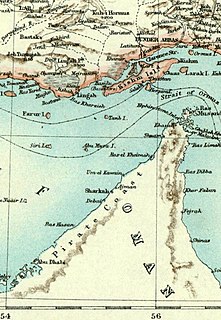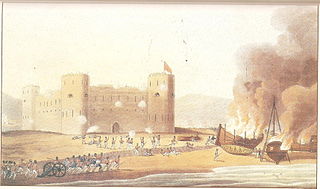Career
In 1810 Vestal was one of the EIC warships the EIC that supported the British Invasion of Isle de France.
Shortly after 18 November 1816 HMS Challenger and the British East India Company's cruisers HCS Ariel, Mercury, and Vestal sailed from Bushire on a punitive expedition against Ras-al-Khaimah. The squadron attacked on 1 December but could not approach the town closely enough for its fire to effect much damage. The squadron did burn some dhows before it withdrew.
Rear Admiral King appointed Captain Collier of HMS Liverpool to command the naval portion of the 1819 joint navy-army punitive expedition against the Al Qasimi at Ras Al Khaimah. The naval force consisted of the Royal Navy vessels Liverpool, Eden, Curlew, and a number of gun and mortar boats. The Bombay Marine contributed six armed vessels: the 16-gun Teignmouth under the command of Captain Hall, the senior captain, the 16-gun Benares, the 14-gun Aurora, the 14-gun Nautilus, the 12-gun Ariel, and the 12-gun Vestal. [5] Later two frigates and 600 men belonging to Said bin Sultan, Sultan of Muscat and Oman joined the expedition. On the army side, Major General Sir William Keir commanded some 3,000 troops in transports, including the 47th and 65th Regiments, the 1st Battalion of the 2nd Regiment of Native Infantry, the flank companies of the 1st Battalion of the 3rd Regiment of Native Infantry and of the Marine Battalion, and half a company of Pioneers. In all, 1,645 European and 1,424 Indian soldiers ('sepoys') and marines took part in the expedition.
The fleet anchored off Ras Al Khaimah on 2 December, landing troops two miles south of the town on 3 December. Collier placed Captain Walpole of Curlew in charge of the gun boats and an armed pinnace to protect the landing, which was, however, unopposed. [7] The bombardment of the town commenced on 6 December, from landed batteries of 12 pound guns and mortars as well as from sea. On 7 December, two 24-pounder cannons from Liverpool were added to the land batteries. When the troops stormed the town on 9 December they found that the inhabitants had all fled. [7] The siege cost the British five dead and 52 men wounded. The Arabs reportedly had lost a thousand dead. [7]
In 1821 Vestal fired on Doha, setting fire to the town and forcing its inhabitants to flee. The cause was Buhar bin Jurban of the Al bu-Aynayn tribe having breached an 1819 treaty between the British and a number of Gulf sheiks who agreed not to harbour pirates. It is not clear that bin Jurban was aware of the treaty, let alone a signatory.
Vestal distinguished herself in one notable action during the First Anglo-Burmese War. On 4 June 1824 Vestal, under the command of Lieutenant James W. Guy, was off Shahporee Island at the mouth of the Naaf River, together with two gunboats, each armed with one 12-pounder carronade. A fleet of 100 Burmese war-boats came out of Mungdoo Creek. The boats were full of men and were armed with guns. They called on the British to surrender. Guy responded with a broadside. After about 10 minutes the Burmese retreated back up the creek, pursued by the two gunboats firing canister as they went. Vestal fired on some boats at Shahporee Island and a stockade. In all, the British estimated that they had destroyed some 14 boats and inflicted 150 casualties. On 7 June Vestal and the gunboats sailed for Chittagong.

HMS Liverpool was a Royal Navy Endymion-class frigate, reclassified as a fourth rate. She was built by Wigram, Wells and Green and launched at Woolwich on 21 February 1814. She was built of pitch-pine, which made for speedy construction at the expense of durability.

The Royal Indian Navy (RIN) was the naval force of British India and the Dominion of India. Along with the Presidency armies, later the Indian Army, and from 1932 the Indian Air Force, it was one of the Armed Forces of British India.

Dhayah Fort is an 18th-century fortification in Ras Al Khaimah, United Arab Emirates (UAE). It is the highest hilltop fort in the UAE and was the site of a battle during the Persian Gulf campaign of 1819, when British troops captured the fort after a brief siege.
HMS Curlew (1812) was a Royal Navy Cruizer class brig-sloop built by (William) Good & Co., at Bridport and launched in 1812. She served with the Navy for only 10 years. During the War of 1812 she sailed from Halifax and captured several American privateers. Her greatest moment was her role in the 1819 British occupation of Ras al-Khaimah. Curlew was sold in 1822 in Bombay. She then had a 13 or so year career as an opium runner for James Matheson, one of the founders of the firm Jardine Matheson.
Some four ships have borne the name Earl of Mornington, named for one or another Earl of Mornington, and two of these ships made voyages for the British East India Company (EIC):

Piracy in the Persian Gulf describes the naval warfare that was prevalent until the 19th century and occurred between seafaring Arabs in Eastern Arabia and the British Empire in the Persian Gulf. It was perceived as one of the primary threats to global maritime trade routes, particularly those with significance to British India and Iraq. Many of the most notable historical instances of these raids were conducted by the Al Qasimi tribe. This led to the British mounting the Persian Gulf campaign of 1809, a major maritime action launched by the Royal Navy to bombard Ras Al Khaimah, Lingeh and other Al Qasimi ports. The current ruler of Sharjah, Sultan bin Muhammad Al Qasimi argues in his book The Myth of Piracy in the Gulf that the allegations of piracy were exaggerated by the Honourable East India Company to cut off untaxed trade routes between the Middle East and India.

HCS Aurora, the Honourable East India Company's Ship Aurora, was a sloop-of-war launched at Bombay for the Bombay Marine, the naval arm of the British East India Company (EIC), to protect the trade in the Indian Ocean from pirates. The French captured her in late September 1810, only to have the British recapture her in early December. She returned to the service of the Bombay Marine, assisting the British Government and the Royal Navy in various campaigns in the East Indies and the Persian Gulf. She was still listed on the rolls of the Bombay Marine on 1 January 1828.
Numerous British vessels that have served the British East India Company (EIC) have borne the name Prince of Wales, after the then current Prince of Wales, the title borne by the heir-presumptive to the throne of the United Kingdom.

HCS Coote was a sloop-of-war that served the British East India Company (EIC) during the 19th century. The Bombay Dockyard launched Coote in 1827. Though the EIC built Coote, her size and armament were equivalent to the retired Cruizer-class brig-sloops.
Diana was a merchant ship built at Cochin, British India, in 1817. She made one voyage to Britain before the British government hired her to transport troops for a punitive expedition against the pirates of Ras al Khaima. It was in connection with that operation that she wrecked off the coast of Muscat in 1820.
Ann was launched at Rotherhithe in the River Thames in 1801. She made eight voyages for the British East India Company (EIC) as an "extra ship", i.e., under charter, between 1801 and 1817. After 1817 she traded with India for some time and she was last listed in 1826.
Hannah was launched at Bombay Dockyard in 1811. Shortly after she was launched, she sailed to England on a voyage for the British East India Company (EIC), where her owners sold her to British owners. She engaged in a single-ship action in 1814 in which she repelled an American privateer. She participated as a transport in a punitive expedition in 1819-1820 to Ras al-Khaimah in the Persian Gulf. She was last listed in 1833.
For the British expedition to the Red Sea (1801) the British government hired a number of transport vessels. The transports supported Major-General Sir David Baird's expedition in 1801 to the Red Sea. Baird was in command of the Indian army that was going to Egypt to help General Ralph Abercromby expel the French there. Baird landed at Kosseir, on the Egyptian side of the Red Sea. He then led his troops army across the desert to Kena on the Nile, and then to Cairo. He arrived in time for the battle of Alexandria. Captain Hardie of Shah Kaikusroo was appointed Commodore of the fleet of country ships.
In 1819 the British government of India decided to mount an expedition to Ras Al Khaimah to suppress piracy in the Persian Gulf.

Pascoa was launched at Calcutta in 1816. She was a "country ship", trading around India and between India and China. She was a transport in 1819-20 during the British punitive campaign against the Al Qasimi pirates. She was lost in 1836.
Orient was launched in 1814 at Calcutta. She sailed to England and from then on was based there. She traded with India into the 1830s. She participated in a naval punitive expedition in 1819, and performed four voyages for the British East India Company. From the 1840s she continued to sail widely until she was condemned in 1865 and sold for breaking up.
Cornwall was launched in 1794 as a West Indiaman. In a little more than three years later she had left on the first of three whaling voyages to the Southern Whale Fishery. On her first whaling voyage she captured a Spanish ship and fought off a French privateer. After her third whaling voyage Cornwall returned to the West Indies trade. Around 1817 new owners sent her to India where a Parsi merchant purchased her. She traded in the Persian Gulf and the Indian Ocean, and also participated as a transport in a naval expedition to the Persian Gulf. She was last listed in 1824.

The Persian Gulf campaign of 1819 was a British punitive expedition, principally against the Arab maritime force of the Al Qasimi in the Persian Gulf, which embarked from Bombay, India in November 1819 to attack Ras Al Khaimah. The campaign was militarily successful for the British and led to the signing of the General Maritime Treaty of 1820 between the British and the Sheikhs of what was then known as the 'Pirate Coast', would become known as the 'Trucial Coast' after this treaty and the territory that today comprises the United Arab Emirates.
Sheikh Humaid bin Abdullah Al Qasimi was Ruler of Ras Al Khaimah from 1869–1900. He survived an attempt to unseat him by the Ruler of Sharjah, with whom he later allied. He re-united Ras Al Khaimah with its secessionist dependencies.
Sheikh Rashid bin Humaid Al Nuaimi was the Ruler of Ajman, one of the Trucial States which today form the United Arab Emirates (UAE), from 1816–1838, leading a force of 50 men to take control of the town from members of the Al Bu Shamis tribe who had settled there and also at Al Heera. At the time, Ajman was a dependency of Sharjah. Five years after his establishment at Ajman, the fort was taken by the Darawisha Bedouin who were removed by the action of the Ruler of Sharjah, Sheikh Saqr bin Sultan Al Qasimi.







